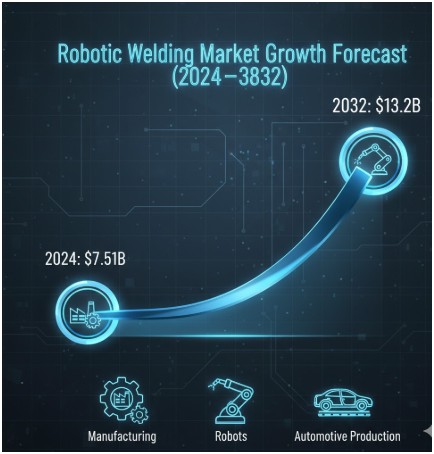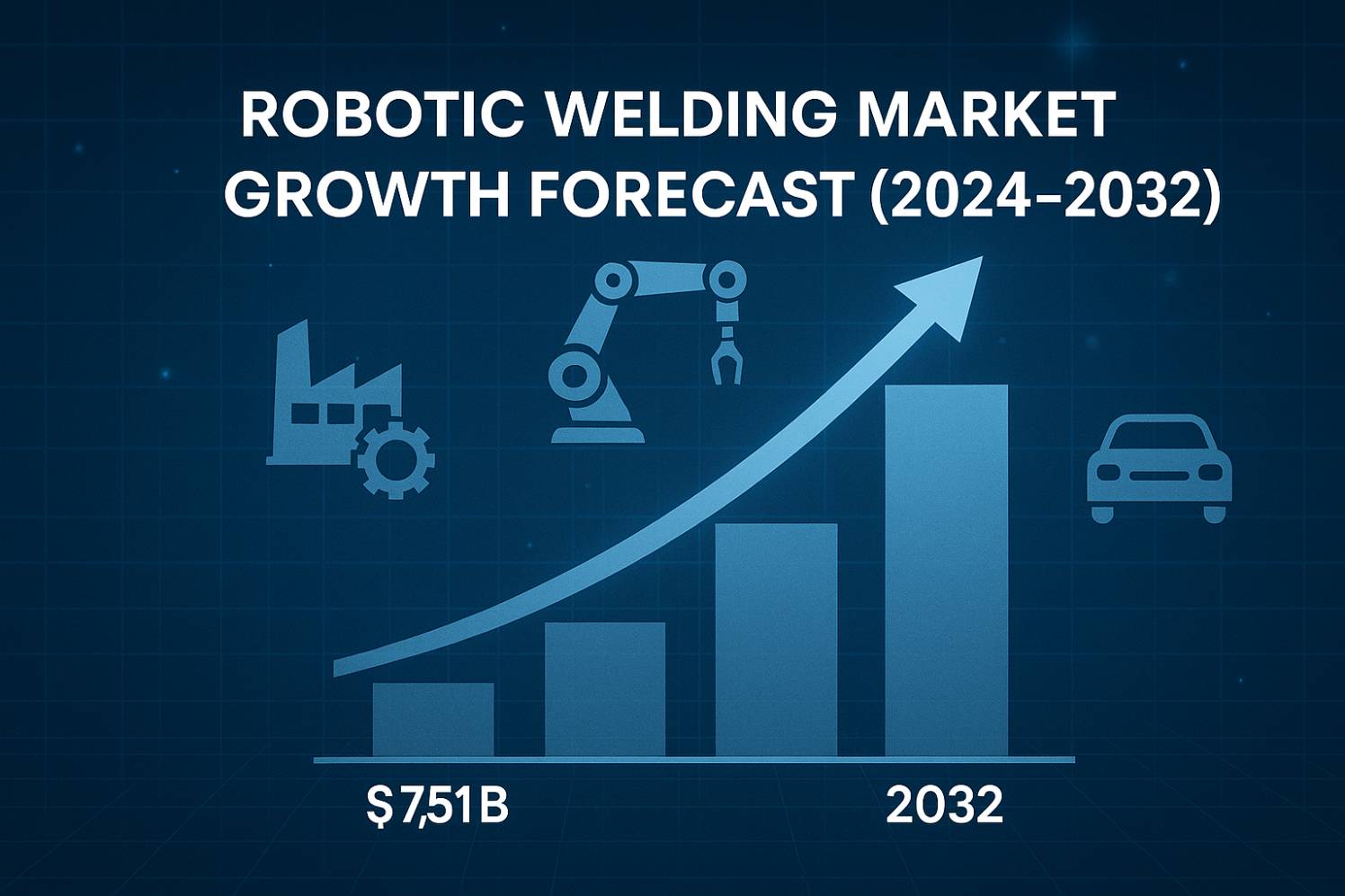When I first walked into an automotive assembly plant a few years ago, the rhythmic hum of robotic arms welding metal panels fascinated me. It was precision in motion—efficient, tireless, and almost poetic. That moment made me realize how far automation has come, and today, the robotic welding market is a perfect example of how technology continues to reshape manufacturing.
How Big Is the Robotic Welding Market Today?

The robotic welding market has witnessed tremendous growth over the last few years. In 2024, it was valued at approximately $7.51 billion, and according to recent projections, it’s expected to soar to $13.2 billion by 2032, expanding at a CAGR of 7.42% between 2025 and 2032.
This growth is powered by rising labor costs, increasing demand for precision manufacturing, and the global push toward automation and smart production systems—collectively known as Industry 4.0.
What Factors Are Driving the Robotic Welding Market?
Several key trends are fueling this rapid expansion, and understanding them reveals why robotic welding is becoming indispensable in modern industry.
1. The Automotive Industry Leads the Way
The automotive sector remains the largest consumer of robotic welding systems. Modern vehicles require thousands of precise welds to ensure structural strength and safety. As global automakers shift toward electric and hybrid models, demand for precision welding in battery frames, chassis, and lightweight materials continues to grow.
2. Industry 4.0 Integration
Smart factories are no longer a futuristic dream—they’re a global reality. Integrating AI, IoT, and advanced robotics allows for predictive maintenance, process optimization, and real-time quality monitoring. These systems reduce downtime and increase productivity, making robotic welding an essential part of next-generation manufacturing.
3. Government Support for Automation
Government initiatives like “Make in India” and “Made in China 2025” are promoting automation and smart manufacturing. By offering tax benefits, subsidies, and policy support, these programs encourage industries to adopt robotic solutions, driving regional growth and innovation.
Which Regions Are Dominating the Robotic Welding Market?
Asia-Pacific: The Growth Engine
The Asia-Pacific region—especially China, India, and Japan—is leading global growth. With strong manufacturing bases, increasing labor costs, and supportive government policies, the region is expected to remain the largest and fastest-growing market for robotic welding systems. China’s vast automotive and electronics industries continue to set the pace, while India’s industrialization and manufacturing boom are driving fresh demand for automation.
North America: Innovation and Steady Growth
In North America, growth remains moderate but stable. The United States leads in adoption across the automotive, construction, and energy sectors, with companies investing in advanced robotic systems to maintain competitiveness and ensure product quality. The push for reshoring manufacturing back to the U.S. also encourages new investments in automated welding technologies.
Europe: Precision and Technology
Europe’s well-established automotive and industrial base ensures steady adoption. Countries like Germany and France continue to integrate advanced robotics, leveraging precision manufacturing as a competitive edge in the global market.
Who Are the Top Players in the Robotic Welding Market?
Some of the world’s leading robotics companies dominate this market, offering cutting-edge welding automation systems:
- ABB (Switzerland) – Known for flexible, high-precision robotic arms.
- Yaskawa Electric Corporation (Japan) – A pioneer in industrial robotics and motion control.
- FANUC Corporation (Japan) – Renowned for reliable, high-speed robotic welders.
- KUKA AG (Germany) – Specializes in collaborative robotic systems and smart factory integration.
- Mitsubishi Electric Corporation (Japan) – Offers integrated automation solutions across industries.
These manufacturers are constantly innovating—introducing AI-enhanced robots, modular systems, and welding solutions that minimize error and optimize production efficiency.
What Are the Key Trends Shaping the Future of Robotic Welding?
1. Spot Welding Robots Continue to Dominate
Spot welding remains the most widely used robotic process, especially in automotive applications. These robots are space-efficient, deliver consistent weld quality, and are ideal for mass production lines.
2. Advanced Sensors and AI Integration
Future robotic welding systems will rely heavily on machine vision and AI algorithms to detect variations in material thickness, positioning, and alignment—ensuring every weld meets exact standards without human intervention.
3. Collaborative Robots (Cobots)
Cobots are transforming the workplace by safely working alongside humans. In welding, cobots improve flexibility for small-batch production while maintaining safety and consistency.
4. Sustainability and Energy Efficiency
As industries strive to lower carbon emissions, energy-efficient robotic systems that reduce waste and optimize material usage will gain traction, aligning with global sustainability goals.
How Can Businesses Benefit from Adopting Robotic Welding?
Implementing robotic welding brings several advantages:
- Consistency and Quality: Robots eliminate human error and fatigue, ensuring every weld meets specifications.
- Higher Productivity: Continuous operation and faster cycle times increase output.
- Cost Efficiency: Despite high initial investment, reduced labor costs and fewer defects lead to strong long-term ROI.
- Worker Safety: Automation minimizes exposure to fumes, heat, and hazardous conditions.
In short, robotic welding isn’t just a technological upgrade—it’s a competitive necessity for manufacturers aiming to thrive in the next decade.
Frequently Asked Questions
1. What industries use robotic welding the most?
The automotive, construction, aerospace, and metal fabrication industries are the primary users. Automotive remains the largest segment due to the volume and precision of welds required.
2. What are the main advantages of robotic welding?
Key benefits include improved precision, faster production, reduced material waste, enhanced safety, and consistent weld quality across mass production.
3. How does Industry 4.0 affect robotic welding?
Industry 4.0 connects machines, sensors, and analytics in real-time. For welding, it means predictive maintenance, automatic quality checks, and greater flexibility in manufacturing processes.
4. Which country leads the robotic welding market?
China currently leads in production and adoption, followed closely by Japan, Germany, and the United States.
Looking Ahead: The Future of the Robotic Welding Market
The robotic welding market is moving from being a luxury to a necessity for global manufacturers. As AI, data analytics, and automation converge, welding robots will become smarter, safer, and more adaptable.
With supportive government policies and industrial digitization accelerating worldwide, the next decade will likely mark a golden era for welding automation.









